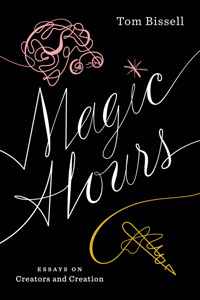
After more than a decade spent writing on subjects as diverse as Uzbekistan, the Iraq War, and video-game voice-overs, Tom Bissell published his sixth book, a collection of some of his finest essays, this April. Titled Magic Hours: Essays On Creators and Creation, the book includes Harper’s Magazine pieces on film from 2000 and 2006, as well as his 2010 feature, “Cinema Crudité,” about the cult movie The Room. Harper’s put six questions to Bissell about art, film, and writing.
1. The first essay in your book, “Unflowered Aloes,” touches upon the role of chance in a writer’s success, pointing out that some great works remain undiscovered because they’re never published or critically praised. Why do you see hope in this?
I like this idea because it implies that there are many wonderful artists out there, doing their thing, not particularly chasing after fame or renown, and making stuff just for the sheer joy and fulfillment of it. Also because it gives average people—you and me, in other words—an enormous amount of responsibility to go looking for stuff on our own, and champion it, and talk about it. Of course, that great artists are toiling out there obscurely is also an incredibly depressing thought, but only if you let depress you.
From Magic Hours:
As you watch and rewatch The Room, categories melt away: Is this a drama? comedy? joke? none of them? all of them? Every filmmaking convention across which it stumbles is sundered. Take the convention of the exterior establishing shot. According to the grammar of film, such a shot is used to indicate the passage of time and spatial relocation to another site within the film’s world. This is not how things work in The Room. At one point, we are at Johnny’s birthday party. [Tommy] Wiseau cuts away to an exterior establishing shot of what appears to be an office building. The viewer assumes—no, believes, given how thoroughly films have trained us—that the next shot will take us inside that office building. The next shot shows us that we are still at the party.
Wiseau understands the placement and required tone of certain conventions but not all their underlying meaning. What makes him interesting is the degree to which his art becomes a funhouse-mirror version, an inadvertent exposé, of a traditional film. He shows, however accidentally, that the devices and conventions we have learned to respond to do not necessarily solve or even do anything. More than any artist I can think of, Wiseau proves Northtrop Frye’s belief that all conventions are, at heart, insane. Or, as I overheard someone say as I left Cinema 21, “Maybe this is what originality looks like now.”
2. Why is The Room art?
Why is anything art? The Room is absolutely art. It’s just horrible, weird, alien, inexplicable art. What’s great about it is that it’s such uniquely bad art. Most terrible films are failed genre films. The Room is an entirely conventional film and story that nevertheless feels like it was transmitted from another planet. That’s why I like it.
3. You note in your essay about Jim Harrison that he doesn’t read any of his reviews, and suggest yourself that “too many critics are incapable of all but obvious commonplaces.” But as you point out elsewhere, even if critics don’t especially help a writer analyze his work, they do influence whether or not anyone will read it. So where should writers seek validation?
In themselves and one or two trusted readers. In the last few years I’ve become completely inured to good or bad things said about my work. I mean, sure, coming across something good or bad still feels pleasant or stings in the immediate aftermath, but mostly I just ask myself if I’d like what I’m doing were I to read it as a reader, and if I can say, “Yup,” I’m satisfied. The only person you need to satisfy creatively is yourself. Period.
4. Your friend Gideon Lewis-Kraus tells us that when you first met, you told him “there are two kinds of writers in the world: writers who help other writers and writers who don’t.” Why do you believe certain writers do or don’t help each other?
Well, there are two ways to look at having a career. One way to look at it is as though there’s a finite amount of attention and praise in this world to be earned and enjoyed, and thus look upon other writers as enemies or Darwinian competitors. The other way is to imagine you’re one of a bunch of lucky people riding a cosmic wave into the shore. Writing is hard. Writing out of anger and resentment is even harder. The best reason to help other writers is to remind yourself why you’re writing anything in the first place: to share something.
5. Your essay on Werner Herzog points out that documentary filmmaking can lend itself to fact-stretching. What can you get away with on film that you can’t on paper?
 It’s really not about getting away with something. I’ve certainly stretched unimportant facts in my nonfiction, and I’ve never looked at it as getting away with something. It’s more about how to express something that’s representationally or emotionally accurate that the straight-up truth just makes sound clumsy or opaque. Making stuff up for the sake of getting away with something is lying. Adumbrating the facts to say something true is art.
It’s really not about getting away with something. I’ve certainly stretched unimportant facts in my nonfiction, and I’ve never looked at it as getting away with something. It’s more about how to express something that’s representationally or emotionally accurate that the straight-up truth just makes sound clumsy or opaque. Making stuff up for the sake of getting away with something is lying. Adumbrating the facts to say something true is art.
6. In “Euphorias of Perrier: The Case Against Robert D. Kaplan,” you write that Kaplan’s “worldview is . . . shared by many Americans. These are people for whom the wider world means only acrimony to be dismissed and obstacles to be knocked over.” How does good travel writing stand a chance in the face of a narrow-minded readership?
I don’t know. I’ve always viewed good travel writing as a way of welcoming the reader into a surrogate experience and reminding him or her of such corny paleoliberal things as the brotherhood of humanity and what have you. I hate travel writing that makes people think, “Gosh, I’d never want to travel there.” I like travel writing—especially travel writing about so-called unpleasant places—that makes the reader think, “I’d love to go there.”



